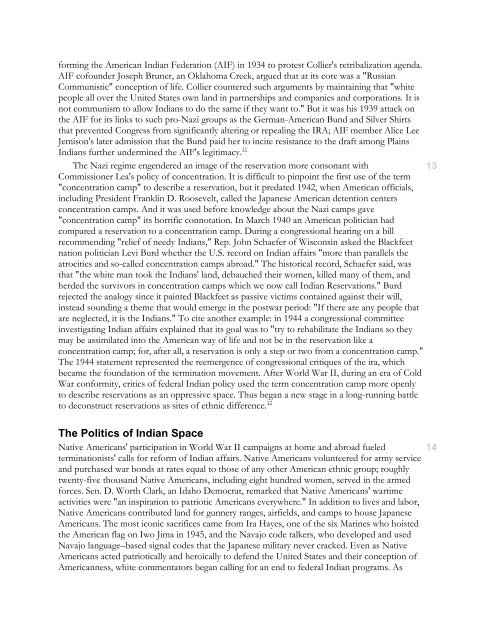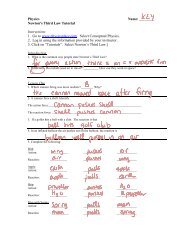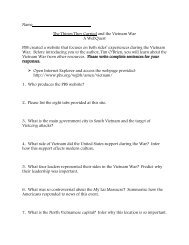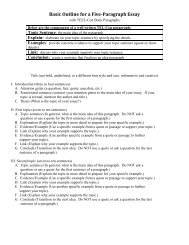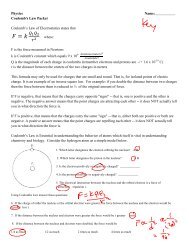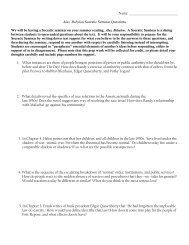Lesson Plan: Indian Activism during the Cold War - Schaumburg ...
Lesson Plan: Indian Activism during the Cold War - Schaumburg ...
Lesson Plan: Indian Activism during the Cold War - Schaumburg ...
Create successful ePaper yourself
Turn your PDF publications into a flip-book with our unique Google optimized e-Paper software.
forming <strong>the</strong> American <strong>Indian</strong> Federation (AIF) in 1934 to protest Collier's retribalization agenda.AIF cofounder Joseph Bruner, an Oklahoma Creek, argued that at its core was a "RussianCommunistic" conception of life. Collier countered such arguments by maintaining that "whitepeople all over <strong>the</strong> United States own land in partnerships and companies and corporations. It isnot communism to allow <strong>Indian</strong>s to do <strong>the</strong> same if <strong>the</strong>y want to." But it was his 1939 attack on<strong>the</strong> AIF for its links to such pro-Nazi groups as <strong>the</strong> German-American Bund and Silver Shirtsthat prevented Congress from significantly altering or repealing <strong>the</strong> IRA; AIF member Alice LeeJemison's later admission that <strong>the</strong> Bund paid her to incite resistance to <strong>the</strong> draft among Plains<strong>Indian</strong>s fur<strong>the</strong>r undermined <strong>the</strong> AIF's legitimacy. 11The Nazi regime engendered an image of <strong>the</strong> reservation more consonant with13Commissioner Lea's policy of concentration. It is difficult to pinpoint <strong>the</strong> first use of <strong>the</strong> term"concentration camp" to describe a reservation, but it predated 1942, when American officials,including President Franklin D. Roosevelt, called <strong>the</strong> Japanese American detention centersconcentration camps. And it was used before knowledge about <strong>the</strong> Nazi camps gave"concentration camp" its horrific connotation. In March 1940 an American politician hadcompared a reservation to a concentration camp. During a congressional hearing on a billrecommending "relief of needy <strong>Indian</strong>s," Rep. John Schaefer of Wisconsin asked <strong>the</strong> Blackfeetnation politician Levi Burd whe<strong>the</strong>r <strong>the</strong> U.S. record on <strong>Indian</strong> affairs "more than parallels <strong>the</strong>atrocities and so-called concentration camps abroad." The historical record, Schaefer said, wasthat "<strong>the</strong> white man took <strong>the</strong> <strong>Indian</strong>s' land, debauched <strong>the</strong>ir women, killed many of <strong>the</strong>m, andherded <strong>the</strong> survivors in concentration camps which we now call <strong>Indian</strong> Reservations." Burdrejected <strong>the</strong> analogy since it painted Blackfeet as passive victims contained against <strong>the</strong>ir will,instead sounding a <strong>the</strong>me that would emerge in <strong>the</strong> postwar period: "If <strong>the</strong>re are any people thatare neglected, it is <strong>the</strong> <strong>Indian</strong>s." To cite ano<strong>the</strong>r example: in 1944 a congressional committeeinvestigating <strong>Indian</strong> affairs explained that its goal was to "try to rehabilitate <strong>the</strong> <strong>Indian</strong>s so <strong>the</strong>ymay be assimilated into <strong>the</strong> American way of life and not be in <strong>the</strong> reservation like aconcentration camp; for, after all, a reservation is only a step or two from a concentration camp."The 1944 statement represented <strong>the</strong> reemergence of congressional critiques of <strong>the</strong> ira, whichbecame <strong>the</strong> foundation of <strong>the</strong> termination movement. After World <strong>War</strong> II, <strong>during</strong> an era of <strong>Cold</strong><strong>War</strong> conformity, critics of federal <strong>Indian</strong> policy used <strong>the</strong> term concentration camp more openlyto describe reservations as an oppressive space. Thus began a new stage in a long-running battleto deconstruct reservations as sites of ethnic difference. 12The Politics of <strong>Indian</strong> SpaceNative Americans' participation in World <strong>War</strong> II campaigns at home and abroad fueledterminationists' calls for reform of <strong>Indian</strong> affairs. Native Americans volunteered for army serviceand purchased war bonds at rates equal to those of any o<strong>the</strong>r American ethnic group; roughlytwenty-five thousand Native Americans, including eight hundred women, served in <strong>the</strong> armedforces. Sen. D. Worth Clark, an Idaho Democrat, remarked that Native Americans' wartimeactivities were "an inspiration to patriotic Americans everywhere." In addition to lives and labor,Native Americans contributed land for gunnery ranges, airfields, and camps to house JapaneseAmericans. The most iconic sacrifices came from Ira Hayes, one of <strong>the</strong> six Marines who hoisted<strong>the</strong> American flag on Iwo Jima in 1945, and <strong>the</strong> Navajo code talkers, who developed and usedNavajo language–based signal codes that <strong>the</strong> Japanese military never cracked. Even as NativeAmericans acted patriotically and heroically to defend <strong>the</strong> United States and <strong>the</strong>ir conception ofAmericanness, white commentators began calling for an end to federal <strong>Indian</strong> programs. As14


